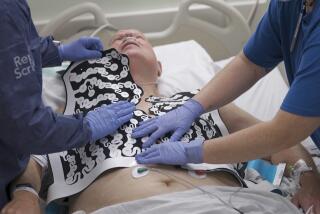FDA Approves Heart Laser for Chest Pain
- Share via
WASHINGTON — The Food and Drug Administration approved a radical and controversial treatment for crippling chest pain Thursday: a laser that zaps up to 40 tiny holes into the heart itself.
The heart laser is only for the small proportion of heart patients who have a debilitating type of chest pain called stable angina that is not helped by conventional therapy, the FDA stressed. That’s because the laser could cause dangerous reactions, including irregular heartbeats, heart attacks, even death, the agency warned.
But, in the right patients, the laser made a big difference, providing dramatic pain relief to most patients, the FDA acknowledged.
“Although we don’t understand why it works, it’s clear that it works,” said Dr. Susan Alpert, the FDA’s medical device evaluation chief. “Some of these patients were essentially bedridden . . . and they were able to get up and go.”
The procedure is called transmyocardial revascularization, or TMR. In a two-hour operation, doctors slice a 4-inch cut between the ribs, insert a small laser and blast 1-millimeter holes into the heart muscle.
The outer heart layers heal almost immediately, but the beating heart is supposed to force the channels to stay open in the interior.
The theory is that pain is relieved by increasing blood flow to muscle areas that have been severely damaged by advanced heart disease.
But several studies, in animals and a handful of human autopsies, have shown the holes almost completely reclosed. That prompted critics to question if the therapy really works or is a placebo effect in which the thought of helpful surgery can make patients feel better.
Last year, the FDA’s independent scientific advisors rejected the laser’s approval, citing problems with studies by the manufacturer, PLC Medical Systems. So the FDA asked PLC to study whether patients’ pain relief lasted a year after laser treatment. If so, that would rule out a placebo effect.
For 72% of the 61 patients tracked for a year, the relief lasted, compared with just 13% of similarly severe angina in patients who found relief from conventional medicine.
The $400,000 laser did not prolong patients’ lives, the FDA said.
But the pain relief was dramatic, and significantly improved their quality of life. So the FDA approved the laser.
About 150,000 Americans have end-stage coronary artery disease, which is almost always accompanied by angina. Medication or heart bypass can significantly help most angina cases.
The laser is intended for patients in severe pain who have failed those therapies. And it’s only for a type of pain called stable angina. The laser is too dangerous for patients with unstable angina, the FDA said. Twenty-two percent of those patients in the clinical trials died after laser surgery, versus just 1% of stable angina patients.
But the FDA warned that the laser also poses a risk of heart attack, irregular heartbeat and stroke. Another risk is that the laser could accidentally fire into the heart valves.
The laser is safe when used by a properly trained surgeon on the right patient, said Dr. Robert March of Rush-Presbyterian-St. Luke’s Medical Center in Chicago, who has treated 85 patients and who will train other surgeons for PLC. “If you select the right patient, then you should expect really a very low operative risk.”
The FDA said that before surgery, patients must sign a form saying they read a special brochure about the laser and understood the risks.
Franklin, Mass.-based PLC estimates the operation will cost about as much as heart bypass, which can range from $20,000 to $40,000.





